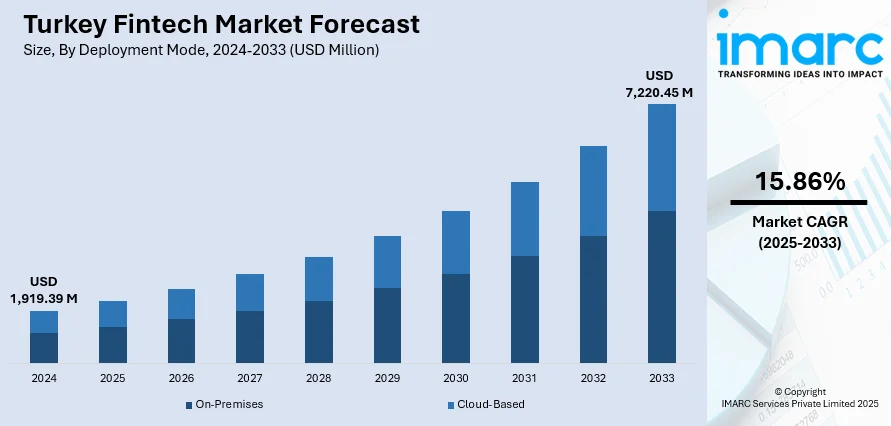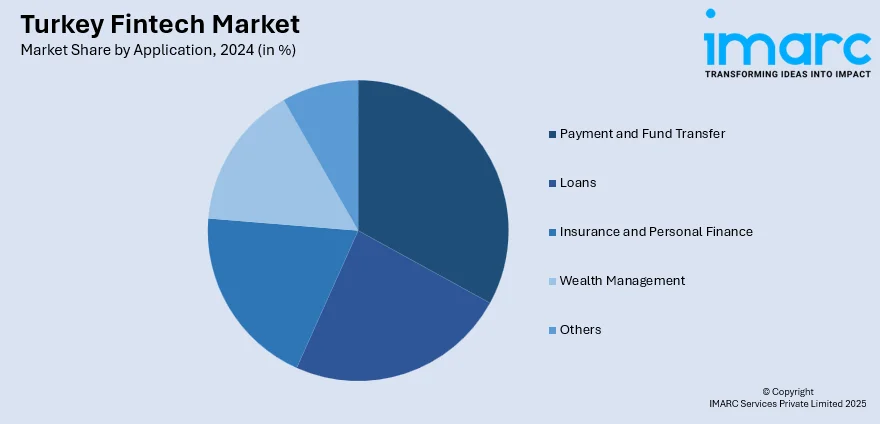
Turkey Fintech Market Size, Share, Trends and Forecast by Deployment Mode, Technology, Application, End User, and Region, 2025-2033
Turkey Fintech Market Overview:
The Turkey fintech market size reached USD 1,919.39 Million in 2024. The market is projected to reach USD 7,220.45 Million by 2033, exhibiting a growth rate (CAGR) of 15.86% during 2025-2033. The market is witnessing robust dynamism, propelled by innovations in deployment modes, emerging technologies, and shifting consumer expectations. Solutions encompassing mobile payments, blockchain, and AI are reshaping applications across banking, e-commerce, and peer-to-peer lending. Fintech firms are aligning strategies with diverse end-users from retail consumers to SMEs tailoring offerings to meet regional needs. As regulatory frameworks evolve and competition intensifies, stakeholders are positioning to influence the sector's trajectory ultimately aiming to enhance their standing in the Turkey fintech market share.
|
Report Attribute
|
Key Statistics
|
|---|---|
|
Base Year
|
2024
|
|
Forecast Years
|
2025-2033
|
|
Historical Years
|
2019-2024
|
| Market Size in 2024 | USD 1,919.39 Million |
| Market Forecast in 2033 | USD 7,220.45 Million |
| Market Growth Rate 2025-2033 | 15.86% |
Turkey Fintech Market Trends:
Expansion of Instant Payment Infrastructure
Turkey is making significant progress in its instant payment infrastructure, which is transforming how individuals and businesses handle everyday financial transactions. In February 2024, the Central Bank introduced the FAST Request-to-Pay overlay service, enhancing the instant payment system by enabling payees to send payment requests directly to payers. This improvement streamlines the payment process, reducing friction and enabling faster, more transparent fund transfers. Such advancements not only increase user convenience but also build greater trust in digital financial services, which is crucial for broader fintech adoption. By fostering a seamless and efficient payment ecosystem, Turkey is positioning itself to support more complex fintech solutions such as peer-to-peer transfers, digital wallets, and programmable payments. This integrated approach is instrumental in expanding digital financial inclusion across various sectors. The ongoing enhancement of payment infrastructure illustrates the country’s commitment to innovation and user-centric financial services, thereby accelerating the evolution of its fintech landscape. These developments underscore the continued momentum in Turkey fintech market trends.

To get more information on this market, Request Sample
Rise of Digital Lending Platforms
Digital lending platforms are increasingly playing a pivotal role in Turkey’s financial ecosystem by expanding access to credit through streamlined, tech-enabled processes. In February 2025, a prominent entrepreneur highlighted that Turkey's banking and financial sector is more advanced than often credited, noting that in terms of financial infrastructure, Turkey is on par with Japan and South Korea. This infrastructure supports the growth of digital lending platforms, which leverage innovative credit scoring methods and automated approvals, allowing underserved segments including small businesses and young entrepreneurs to access financing more quickly and with less paperwork. The expansion of digital lending is aligned with broader fintech development goals in Turkey, fostering a more agile and inclusive financial landscape. The growing popularity and acceptance of these services highlight their crucial contribution to both economic dynamism and digital transformation. As fintech continues to reshape financial services, the progress seen in digital lending represents a significant catalyst for the Turkey fintech market growth.
Strengthened Regulatory Framework for Digital Assets
Turkey has taken meaningful steps to bolster oversight and accountability in digital asset operations, signaling its readiness for a more mature fintech environment. In June 2025, Finance Minister Mehmet Şimşek announced new safeguards for cryptocurrency transactions including mandatory 48‑ to 72‑hour waiting periods for withdrawals when the travel rule isn’t applied to curb illicit activity and enhance transparency. These rules introduce deliberate pacing for stablecoin transfers and reinforce verification protocols for both senders and recipients. Rather than prioritizing flashy innovations, the focus is on embedding trust and reliability into fintech, ensuring users and markets feel more secure. Steady, well‑thought‑out regulation tends to promote long‑term confidence more than flashy features. With clearer frameworks in place, Turkey’s fintech ecosystem is becoming more resilient and credible especially when handling sensitive transactions like crypto. That thoughtful approach to regulation lays the groundwork for broader fintech solutions that require user trust as a foundation. It’s this combination of ambition and prudence that truly defines the evolving Turkey fintech market.
Turkey Fintech Market Segmentation:
IMARC Group provides an analysis of the key trends in each segment of the market, along with forecasts at the country and regional levels for 2025-2033. Our report has categorized the market based on deployment mode, technology, application, and end user.
Deployment Mode Insights:
- On-Premises
- Cloud-Based
The report has provided a detailed breakup and analysis of the market based on the deployment mode. This includes on-premises and cloud-based.
Technology Insights:
- Application Programming Interface
- Artificial Intelligence
- Blockchain
- Robotic Process Automation
- Data Analytics
- Others
The report has provided a detailed breakup and analysis of the market based on the technology. This includes application programming interface, artificial intelligence, blockchain, robotic process automation, data analytics, and others.
Application Insights:

- Payment and Fund Transfer
- Loans
- Insurance and Personal Finance
- Wealth Management
- Others
A detailed breakup and analysis of the market based on the application has also been provided in the report. This includes payment and fund transfer, loans, insurance and personal finance, wealth management, and others.
End User Insights:
- Banking
- Insurance
- Securities
- Others
A detailed breakup and analysis of the market based on the end user has also been provided in the report. This includes banking, insurance, securities, and others.
Regional Insights:
- Marmara
- Central Anatolia
- Mediterranean
- Aegean
- Southeastern Anatolia
- Black Sea
- Eastern Anatolia
The report has also provided a comprehensive analysis of all the major regional markets, which include Marmara, Central Anatolia, Mediterranean, Aegean, Southeastern Anatolia, Black Sea, and Eastern Anatolia.
Competitive Landscape:
The market research report has also provided a comprehensive analysis of the competitive landscape. Competitive analysis such as market structure, key player positioning, top winning strategies, competitive dashboard, and company evaluation quadrant has been covered in the report. Also, detailed profiles of all major companies have been provided.
Turkey Fintech Market News:
- April 2025: FaturamPara, an innovative Turkish firm that brings together both RegTech and FinTech expertise, has become a member of the SME Finance Forum. Its membership aligns with its vision of further developing digital financial services for small and medium enterprises. FaturamPara is acknowledged for simplifying financial processes related to electronic invoicing and provides end-to-end solutions in payment, credit, and compliance functions. Its involvement in this worldwide network speaks to Turkey's increasing position in innovative financial technologies and the firm's dedication to transforming digital finance in the region.
- May 2024: Turkish fintech company Iyzico has purchased Paynet, a leading Istanbul payments provider, in a strategic acquisition that expands its services and increases its operating presence. Paynet's B2B and B2B2C payment features added to Iyzico's platform enhance its presence in Türkiye's digital payments segment. The transaction, which has received regulatory support from national officials, is a significant marker in the development of the nation's fintech sector and points toward increased momentum in financial innovation.
Turkey Fintech Market Report Coverage:
| Report Features | Details |
|---|---|
| Base Year of the Analysis | 2024 |
| Historical Period | 2019-2024 |
| Forecast Period | 2025-2033 |
| Units | Million USD |
| Scope of the Report |
Exploration of Historical Trends and Market Outlook, Industry Catalysts and Challenges, Segment-Wise Historical and Future Market Assessment:
|
| Deployment Modes Covered | On-Premises, Cloud-Based |
| Technologies Covered | Application Programming Interface, Artificial Intelligence, Blockchain, Robotic Process Automation, Data Analytics, Others |
| Applications Covered | Payment and Fund Transfer, Loans, Insurance and Personal Finance, Wealth Management, Others |
| End Users Covered | Banking, Insurance, Securities, Others |
| Regions Covered | Marmara, Central Anatolia, Mediterranean, Aegean, Southeastern Anatolia, Black Sea, Eastern Anatolia |
| Customization Scope | 10% Free Customization |
| Post-Sale Analyst Support | 10-12 Weeks |
| Delivery Format | PDF and Excel through Email (We can also provide the editable version of the report in PPT/Word format on special request) |
Key Questions Answered in This Report:
- How has the Turkey fintech market performed so far and how will it perform in the coming years?
- What is the breakup of the Turkey fintech market on the basis of deployment mode?
- What is the breakup of the Turkey fintech market on the basis of technology?
- What is the breakup of the Turkey fintech market on the basis of application?
- What is the breakup of the Turkey fintech market on the basis of end user?
- What is the breakup of the Turkey fintech market on the basis of region?
- What are the various stages in the value chain of the Turkey fintech market?
- What are the key driving factors and challenges in the Turkey fintech market?
- What is the structure of the Turkey fintech market and who are the key players?
- What is the degree of competition in the Turkey fintech market?
Key Benefits for Stakeholders:
- IMARC’s industry report offers a comprehensive quantitative analysis of various market segments, historical and current market trends, market forecasts, and dynamics of the Turkey fintech market from 2019-2033.
- The research report provides the latest information on the market drivers, challenges, and opportunities in the Turkey fintech market.
- Porter's five forces analysis assist stakeholders in assessing the impact of new entrants, competitive rivalry, supplier power, buyer power, and the threat of substitution. It helps stakeholders to analyze the level of competition within the Turkey fintech industry and its attractiveness.
- Competitive landscape allows stakeholders to understand their competitive environment and provides an insight into the current positions of key players in the market.
Need more help?
- Speak to our experienced analysts for insights on the current market scenarios.
- Include additional segments and countries to customize the report as per your requirement.
- Gain an unparalleled competitive advantage in your domain by understanding how to utilize the report and positively impacting your operations and revenue.
- For further assistance, please connect with our analysts.
 Request Customization
Request Customization
 Speak to an Analyst
Speak to an Analyst
 Request Brochure
Request Brochure
 Inquire Before Buying
Inquire Before Buying




.webp)




.webp)












